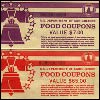Session Overview

|
Individuals make decisions about what to buy and when. But when we talk about the economy every day, we are often analyzing what millions of people are doing and deciding to do at different times. In order to think about this problem, we need to move from the micro to the macro and use our model of individual behavior to generate predictions about what will happen to total demand when the price changes. Vintage food stamps. Image courtesy of Brian on Flickr. |
Keywords: Constrained budget; price elasticity; Engel curves; income effect; substitution effect.
Session Activities
Readings
Read the recitation notes, which cover new content that adds to and supplements the material covered in lecture.
Before watching the lecture video, read the course textbook for an introduction to the material covered in this session:
- [R&T] Chapter 7, “The Analysis of Consumer Choice.” Section 7.2.3.
- [Perloff] Chapter 5, “Applying Consumer Theory.” (optional)
Lecture Videos
Resources
Check Yourself
Concept Quiz
This concept quiz covers key vocabulary terms and also tests your intuitive understanding of the material covered in this session. Complete this quiz before moving on to the next session to make sure you understand the concepts required to solve the mathematical and graphical problems that are the basis of this course.
Question 1
What is the definition of the income elasticity of demand?
Percentage change in quantity demanded for a given percentage change in price is the price elasticity of demand, and percentage change in quantity demanded for a given percentage change in the price of the other good is a cross-price elasticity.
Question 2
What is a plausible example of a good with negative income elasticity (i.e., an inferior good?)
Rice is a cheap staple food that is generally consumed by poor people; as they become richer, they will consume less rice and consume more of other types of foods. Sports cars, steak and jewelry are all luxury goods, which are generally not inferior goods.
Question 3
Assume you are consuming two goods, and the price of one increases. However, you are given extra income to ensure that your utility does not decrease. What happens to your consumption of the good with the higher price?
The question describes the substitution effect, and we know that the substitution effect has to be negative: an increase in prices causes you to substitute away from the good whose price is increasing, holding utility constant.
Question 4
In order to analyze the total effect of a change in price on the total consumption of a good, we decompose it into two components. What are the names of these two components?
'Normal' and 'inferior' are descriptive terms that can be used to describe whether the income effect is positive or negative, but they are not separate components of an overall price effect.
Other OCW and OER Content
| CONTENT | PROVIDER | NOTES |
|---|---|---|
| “The Expenditure Function: An Application to the Economics of Food Stamps.” Lec #5 in 14.03 Microeconomic Theory and Public Policy, Fall 2010. | MIT OpenCourseWare | Alternative notes with an advanced theoretical approach. |










